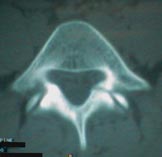- See: Occult Spondylolysis
- Discussion:
- spondylolysis is rarely symptomatic in adolescents;
- in children, be especially concerned if symptoms that do not respond to rest or immobilization or if there are neurological findings.
- diff dx:
- disc-space infection
- osteoid-osteoma
- spinal cord tumor
- slipped vertebral apophysis
- herniated disc
- scheuermann disease
- rheumatoid spondylitis
- Exam:
- neurologic lesions are uncommon;
- pts usually have no pain on flexion;
- hamstrings are minimally tight & pts can often touch floor with their fingers;
- pain is usually quite localized unilaterally & exacerbated by hyperextension;

- Radiographs:
- although radiographs may show stress fracture of pars interarticularis, this is usually not found at early presentation;
- Bone Scans
- allows early diagnosis;
- establishes level of stress reaction or stress fracture;
- differentiates between established nonunions and those defects with continued potential healing.
- Treatment: Symptomatic Spondylolysis:
- symptoms from spondylolysis will commonly resolve w/ non operative care and activity limitation;
- bed rest and total cessation of sports are usually not necessary for the successful treatment of this problem;
- pts w/ painful spondylolysis with minimal or no slip should be treated conservatively for at least 6 to 8 months;
- bracing:
- if symptoms persist in spite of activity modification, bracing or surgery might be indicated;
- pts w/ painful spondylolysis, but w/ no slip, should be treated by bracing for 6 to 8 months and then gradual brace removal;
- references:
- Treatment of symptomatic spondylolysis and spondylolisthesis with the modified Boston brace.
- Brace treatment for symptomatic spondylolisthesis.
- surgery:
- painful spondylolysis not responding to orthosis after 6-8 months, requires surgery;
- if there is L5 pars defect, an L5-S1 arthrodesis should be done;
- do not include L4 in the fusion area;
- decompression is required only for a focal neurologic deficit and not for leg pain only, which will resolve with fusion;
- reduction should be considered only for slips with a slip angle greater than 55 degrees;
- L4 Defect:
- chronically painful L4 pars defect w/o displacement is probably best treated by a direct repair of the lesion;
- this method preserves good lumbar spine motion and is much preferable to an L4-S1 arthrodesis
Fracture of the pars interarticularis in adolescent athletes: a clinical-biomechanical analysis.
Lumbar spondylolysis and spondylolisthesis in college football players. A prospective study.
Treatment of symptomatic spondylolysis and spondylolisthesis with the modified Boston brace.
Brace treatment for symptomatic spondylolisthesis.
Significance of lumbar spondylolysis in college football players.
Spondylolysis and spondylolisthesis in children.
Pars interarticularis stress reaction, spondylolysis and spondylolisthesis in gymnasts.
The mechanical etiology of spondylolysis and spondylolisthesis.

